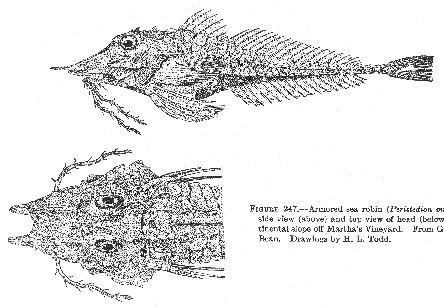Armored sea robin Peristedion miniatum Goode 1880
[Jordan and Evermann, 1896-1900, p. 2178.]
Description—
The armored robin resembles the sea robins in general body form, and in the arrangement [page 472] of its fins, including the fact that the two lower rays of each pectoral form separate feelers. But its body is entirely clothed with bony plates of considerable size. There are 4 rows of these on each side, from the vent rearward, with an equal number of rows of thornlike spines, the latter close set and directed rearward. The plates on the abdomen have no spines. Thanks to this armor, the trunk is very stiff. The lower jaw bears a number of short fleshy barbels; there is one long barbel with short side branches at each corner of the mouth (the sea robins have no barbels); and the front of its head is given so peculiar an appearance by the two projections from the skull (p. 467) that the armored robin could hardly be mistaken for any other fish, except for one of its own tribe.
Color—
Bright crimson, below and above.
Size—
Maximum recorded length between 13 and 14 inches (330-355 mm.).
Habits—
This is a ground fish, recorded from depths ranging from 50 fathoms down to somewhere between 200 and 235 fathoms. And it seems to be confined to the zone of warm water along the outer part of the continental shelf and upper part of the continental slope for the lowest temperature in which it has been recorded is between 44° and 45°.[70] The stomachs of those we have opened contained shrimps, stomatopods, and other small crustaceans.
General range—
Outer part of the continental shelf and upper part of the continental slope; from the southwestern face of Georges Bank to the offing of Charleston, S. C. (lat. 32° 24' N., long. 78° 44' W.).[71]
Occurrence in the Gulf of Maine—
Trawlers tell us they sometimes take these brilliant crimson fishes on the southwestern part of Georges Bank. And they must be rather common outside the 60-fathom contour, for we saw 89 specimens trawled there and south of Nantucket at depths of 66 to more than 185 fathoms, by the Albatross III in May 1950. But it is probable that they are barred from the more easterly parts of the bank and from the inner parts of the Gulf of Maine by low temperature.
